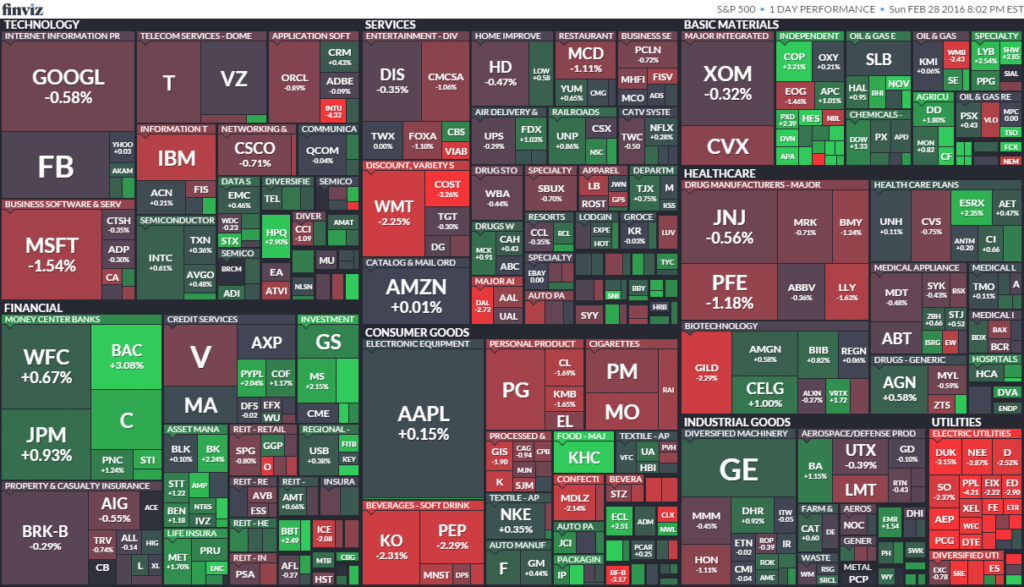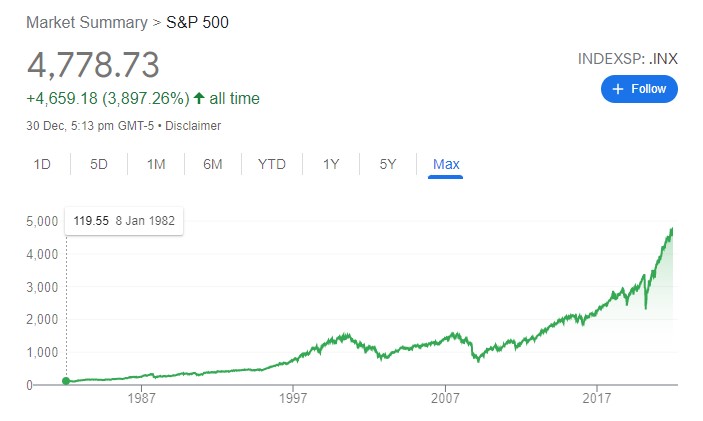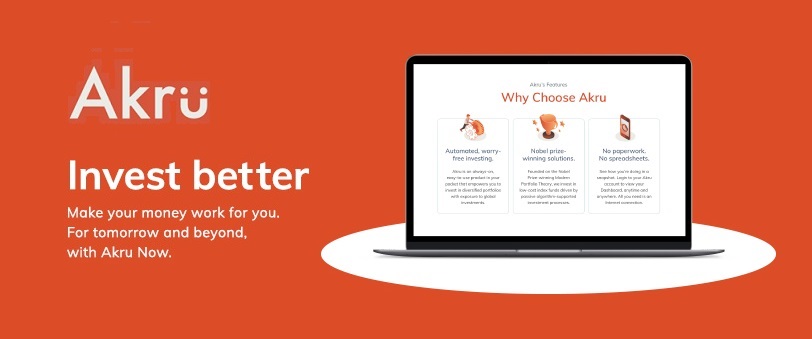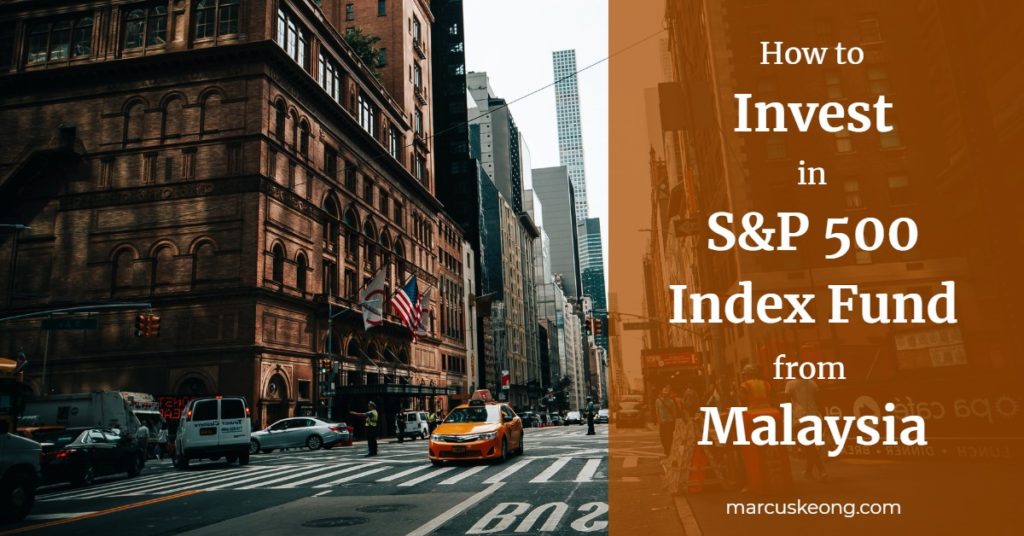This is a long-awaited article in which I’m going to share with you on how to invest in an S&P 500 index fund in Malaysia.
If you know Warren Buffett, you should know that he’s also the CEO of Berkshire Hathaway. In one of the Berkshire shareholder letters, Warren Buffett often shares the same piece of investment advice.

If you are new to investing, you probably have no idea what is an S&P 500. No worry, I got you covered.
What is S&P 500

The Standard & Poor’s 500, also known as S&P 500 is a stock market index that tracks the performance of 500 large companies listed in the US. It is the most followed index by investors around the world.
If you have been reading about investing articles, you may have heard of the term “beating the market”. This “market” is actually referring to the S&P 500 index.
If we invest in an S&P 500 index fund, it also means we are investing in “the market” itself. Instead of beating or losing the market, we will get the market performance for our investments.
3 Reasons to Invest in an S&P 500 index fund
Decent Returns Over Decades

The main purpose of investing in an asset is, of course, its returns. Over the decades, S&P 500 has proved to always go up in the long run.
Of course, it is not a smooth ride. There are years that you may end up with losses instead. But if you have a long investing horizon of at least 10 years, then investing in S&P 500 is a wise choice.

The above charts show the S&P 500 annual return (including dividends) in the recent 10 years. You may say, why are the returns so inconsistent? There’s even a negative return.
Well, this is the nature of the stock market. There’s up and down. But if we zoom out and look at the average return, you will have a whopping 14.5% annual return.
Can you get this kind of return in EPF or Fixed Deposit? I doubt so.
Naturally Diversified
When we invest in an S&P 500 index fund, it is equivalent to investing in 500 companies. Hence, our investment is naturally diversified.
With that, our risk is reduced. But how?
If we invest in individual companies, we may be unlucky to invest in a bad company with losses and may even go bust. When that happens, our money invested will be as good as gone.
But with the top 500 US companies, it is almost impossible for all of them to go bust. Moreover, there is also another characteristic of the S&P 500 index fund that reduces the risk even further, which I will mention in the next point.
Self-Cleansing
As I said, S&P 500 index represents a basket of the largest 500 companies in the US. By right, these 500 companies will not always be the same 500 companies. There will be a rebalancing that happens every quarter or every 3 months.
Here are the rules or criteria for a company to be included in the S&P 500 index:
- $13.1 billion market capitalization (for June 2021)
- Its annual traded value is at least its market capitalization
- At least 250k shares traded in the last 6 months
- Most of its share is in the public’s hands
- Listed in the market for at least one year and above
- Have positive earnings for the last 4 quarters
S&P 500 Index’s Criteria Source: Investopedia
In every rebalancing, bad ones are removed, good ones are included. Since this process is automatically done every quarter, we can call it self-cleansing.
By investing in an S&P 500 index fund, our asset rebalancing takes place automatically every quarter. This makes our investing work a lot simpler.
Now you know why we should invest in S&P 500. Next, we look at which S&P 500 index fund to invest in.
What is the best S&P 500 Index Fund
Basically, every index fund that tracks the S&P 500 index will have a very similar return over time. The only difference is the expenses ratio, A.K.A. the fee charged.
In the US, Vanguard is the first and most reputable index fund provider. Hence, investing in the Vanguard S&P 500 ETF (VOO) will never go wrong. Its expenses ratio is just 0.03%.
Meanwhile, you may need to consider the price of each S&P 500 index fund if fractional shares are not available in your brokerage account (such as TD Ameritrade).
Here are other S&P 500 index funds available in the US market with low expenses ratios:
- Vanguard S&P 500 ETF (VOO) – $436.57
- iShares Core S&P 500 ETF (IVV) – $476.99
- SPDR Portfolio S&P 500 ETF (SPLG) – $55.83
Note: Stock Prices obtained on 31 Dec 2021
If you cannot afford to buy one VOO share, then SPLG might be a cheaper option.
How Can I Buy S&P 500 in Malaysia
For Malaysians, there are 3 ways we can invest in the S&P 500 index funds.
Invest with an International Broker

This is my recommendation for investing in S&P 500 funds. There is no better way than directly investing in one.
Personally, I prefer TD Ameritrade due to its zero-commission fee. But most people recommend IBKR as it allows investors to buy fractional shares.
Related: How to Register a TD Ameritrade Account in Malaysia
The drawback for international brokerages is they are not regulated by Malaysian SC. It means we may need to bear the risks of losing money in any unforeseen circumstances.
Hence it is important to invest in reputable brokerages such as TD Ameritrade and Interactive Brokers (also known as IBKR).
Another drawback of international brokerages is the transfer fee incurred when funding our accounts. Hence this method might not suit investors with small capital (less than RM10k)
Related: How to Fund Your TD Ameritrade Account in Malaysia
If you are fine with those drawbacks mentioned, investing in an S&P 500 index fund becomes simple. When you have a funded account, just search for the stock symbols like VOO and buy them.
If you are interested in registering an IBKR account, check out this step-by-step video by Ziet Invest.
Invest via a Robo-advisor

For those who have small capital but insist on investing in S&P 500 funds, I have good news for you.
Akru Now is the first homegrown robo-advisor that invests in mainly S&P 500 ETF and other ETFs. Even though it doesn’t provide a portfolio with only S&P 500 ETF, it is still good enough for investors to invest part of their money in S&P 500 ETF.
Here are the pros and cons of Akru Now:
Pros:
- Low annual fee of just 0.7% per annum compared with its rivals.
- Regulated by Malaysian Security Commission (SC).
- No minimum deposit, can invest with just 1 cent.
- Invest in the well-known S&P 500 ETF.
- Provide simple performance tracking and goal setting, suitable for new investors.
Cons:
- Can only be accessed via browsers as it does not have a mobile app.
- Still in the development phase and many missing features such as goal edit, portfolio change, recurring deposit, and education portal.
- RM1 fee will be charged for funding via online payment, only manual deposit (via bank transfer) is free.
- There are some interface glitches in the Akru website.
- Less exposure and user population as it lacks features and promotions.
Akru provides 10 types of portfolios with different ratios for stocks and bonds. Other than S&P 500, Akru also invests in equity ETFs such as iShares Core MSCI EAFE ETF (IEFA) and iShares Core MSCI Emerging Markets ETF (IEMG).
Here is the table showing the allocation of each equity ETF in different portfolios:

I skip Portfolio 1 to Portfolio 4 as the allocation of VOO (S&P 500 ETF) is too low.
If you have been investing for some time, I would recommend Portfolio 10 with the most allocation in VOO. Else, you can choose the one that suits your risk tolerance.
For Akru’s annual fee, here’s a table showing different fees in each tier of balance.

You can register an Akru account here: Get Started – Akru
Invest with a Local Broker
The third option is using local brokerages to invest in foreign stocks. As far as I know, bank brokers usually have this option. Other security firms brokers (such as M+ Online) may have it but need to apply for the feature separately.
However, I don’t really recommend choosing this option due to its high fees. They charge us US$25 for every transaction, which is equivalent to at least RM100. Imagine buying S&P 500 index fund every month. That’s RM1,200 damage in a year just paying for brokerage fees.
Not to mention that they also charge other miscellaneous fees such as dividend fees and custodian fees, which do not exist in foreign brokerages.
Summary
Investing in the S&P 500 is probably the simplest way to grow your wealth. There are many points that justify this statement:
- Decent returns over decades
- S&P 500 is naturally diversified
- It is self-cleansing hence no rebalancing is needed
- Less hassle when you only need to invest in one fund
Unfortunately, for my Muslim readers, the S&P 500 index fund is not shariah compliant.
But fret not, there is another option for you guys to invest in US stocks that are shariah-compliant. It is by investing in Wahed Invest.
Here’s an article you are probably interested in:
Wahed Invest Portfolio Review: Invest in What You Know
If you find this article helpful, feel free to share this with your friends who might need this.


Hi
Which one do you recommend to use for Low cost and safest option ?
What I mean safe is that the company wouldn’t go bankrupt or runaway.
Hi, I don’t think there is a company that wouldn’t go bankrupt or runaway.
Investing in individual companies always have a risk of they gone bankrupt, and we can do nothing about it.
But what we can do is to diversify our investment to several companies, so if one company go bankrupt, it won’t fail 100% of our investments.
The point of this article is to recommend us to invest in index fund, which is already diversified to top 500 companies in the US.
Hi,
Thanks for the informative blog.
Can you explain are we subjected to below taxes when investing via online platform like Stashaway, versa, moomoo, Rakuten, Washed and etc, in US equities? If yes, how much?
1. Withholding tax on dividen
2. Capital gain tax
3. Estate tax
I think these is essential information to know before start investing into US market. Can you please share anything if you could.
Thanks a lots in advanced.
1. Withholding tax on dividend – yes, our dividend will be pre-taxed before we received it
2. Capital gain tax – no we are not subjected to this tax as it is US-based
3. Estate tax – also known as inheritance tax, it will be subjected to our local (Malaysian) tax, not the US one.
Hi,
Other than with witholding 30% tax on dividen, don’t we have to pay capital gain tax when selling at profit? As capital gain is taxed even for US citizen, what more for foreigner like us?
Also have you considered on estate tax as when the investment has grown to a significant amount throughtout many years of long term investment over 10 or even 20years?
Just to get your opinion on the above.
Thanks a lots for your kind advice and assistance.
Hi, AFAIK there will be no capital gain tax subjected to non-US citizens who invested in the US stocks.
I have been investing in US index funds and companies for over 3 years, and I did not get taxed or being chased for tax from selling them with capital gains.
For estate tax, I have no idea yet as my investment years are not longer than 10 years.
But from what I know from reading other local financial articles, estate tax will be subjected to our local law, not the US one.
Is it better if we invest in S&P 500 ETF using Regular Saving Plan by FSMONE. The charges is US$1 only or 0.08%. Any other ways to avoid the US 30% Dividend Withholding Tax?
Hi Mushi, so far we cannot escape from the 30% dividend tax as the dividends are already taxed before cashing out to us investors.
I just checked the FSMONE website, the processing fee charge is 0.08% or a minimum of US$8.80. Did I miss out on anything about the US$1 fee?
Anyway, you can still use FSMONE if you are already using it. I avoid it as their fee is not cheap.
I use Rakuten Trade these days as it’s about RM8 per trade. I just make sure that I invest enough so that the brokerage fee is less than 1% of my investments. I am tempted to use IBKR for Irish-domiciled ETFs, but I’m pretty concerned about it being unrecognised by SEC, although everyone reassures me that it’s not a big deal.
About US ETFs, I started by buying VOO, but thanks to you I found about VTI, so now it’s my favourite US equity ETF, which I pair with VXUS, a world ex-US ETF. Now I’m thinking of just investing in VT for simplicity’s sakes. (It’s VTI + VXUS, but with less companies). Too tiring to make separate transactions.
Simplifying your investment will always be a good idea if it doesn’t significantly affect your investment return.
For choosing a suitable brokerage for yourself, I would say each to their own. Some prefer to play safe, while some prefer the variety of investment choices. As long as you know well about the broker you chose, that’s all matter. 🙂
rakuten now also have foreign trading.. Do u apply for that?
I’m not familiar with the US brokerage fee & tax etc, Just wonder is it worth to use rakuten to trade US stock?
Hi, I haven’t register Rakuten foreign account yet.
But if you already have a Rakuten account and not yet have any foreign brokerage, then it will be a good idea to sign up for one.
we have account in FSMONE
can we invest in S&P 500 or Vanguard S&P 500 ETF (VOO)
are the fees high
please advice tq
Yes, you can buy VOO via FSM One as well.
But there is a minimum transaction fee of US$8.80 per trade.